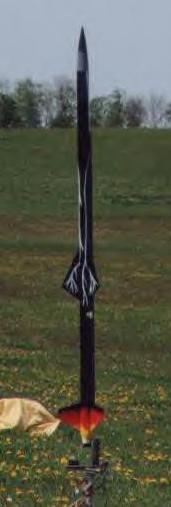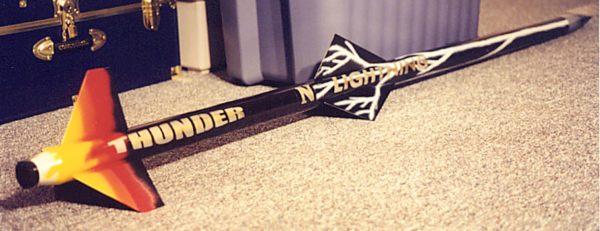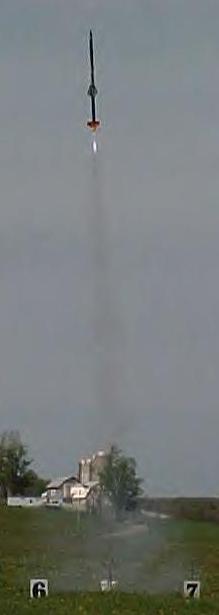Public Missiles Thunder -N- Lightning
Public Missiles - Thunder -N- Lightning
Contributed by David Kneble
| Manufacturer: | Public Missiles  |

(by David Kneble - 05/01/02)
 Brief:
Brief:
This is a high performance 38mm two stage rocket. It features PML's CPR3000
system and the inter-stage coupler unit.
Construction:
I believe that when I originally counted the components there were over 125
pieces. Basically there were two sets of G10 fins, two 38mm motor mounts, the
inter-stage assembly, a tailcone, the airframe for the booster, three airframe
sections for the sustainer (one slotted, one fore recovery airframe, one aft
recovery airframe), two piston assemblies for the sustainer and one for the
booster, a 30" parachute for the booster, a streamer to act as a drogue
for the sustainer, and a 48" chute to be the main for the sustainer. Also
included there were several components such as altimeter mounts and switches to
be used in relation with the electronics.
This was only my second PML kit, their 1/4 Scale Patriot being my first, and it was much more complicated. The assembly was not hard in any particular way as long as you followed the directions closely and took it one step at a time. I did have a couple of difficulties though.
First, applying the internal epoxy fillets to the fins was very difficult. I ended up using a 1/8" diameter dowel and took my time in applying the fillets. This is also made difficult by the fact that you can not get any excess epoxy on the inside of the sustainer fin can when making the fillets. If you do, you will have a very difficult time getting in the rear centering ring.
Next, the coupler for joining the fin can to the aft recovery airframe is too long. It leaves almost no room for the drogue and so it should be shorten about an inch. You also need to take care when assembling the threaded airframe couple for the use of CPR. The position and fit of the threaded aft and fore couplers need to be perfect to achieve a good, sturdy fit. Also, my piston units were very tight and required quite a bit of sanding.
One flaw in the instructions was that the assembly of the booster recovery system had been left out. This was quite easy to do without instructions and PML says that this issue will be addressed in coming instructions.
My last issue deals with the recovery systems of both the booster and the sustainer. First, the sustainer weighed in a little more than expected and since I believe the rocket to be a little heavy for this size chute in the first place, I am going to use a 54" chute instead of a 48" for the main. Finally, my booster section weighed in at almost a pound over PML's estimated weight. As it is, the 30" chute only fits in the airframe with a little bit of squeezing, but I will be upgrading the chute size to 36" and probably finding some way of packing it really small. You might also consider removing the piston unit and replacing it with just a simple Kevlar® parachute protector which would take up less space than the piston and give you more room for the chute.
Overall, construction was pretty simple, it just took a while. As long as you test fit everything, make sure you know everything that has to be done in a step, and follow the directions exactly (ask PML if you have a question or concerns) you should be fine.
One last thing, make sure you sand everywhere that epoxy will be applied to.

Finishing:
For the finishing of my kit I decided to go a little overboard. First, I went
through the routine sanding, cleaning, priming, sanding, cleaning, priming,
sanding, and cleaning get a nice smooth surface to apply the paint to. The
primer also helps the paint adhere better. Then, the first thing I did was
paint the whole thing gloss black with about three coats of paint. Then I faded
the bottom portion of the booster from black to white, going through red,
orange, and yellow to achieve the fade. Then, on the sustainer, I airbrushed
lighting bolts on around the whole thing in gloss white paint. Then I added
lettering to it. To do this I first made a design in Printshop that was the
size and font lettering I wanted. Then I printed out the design and transferred
it to a piece of posterboard. Then I cut out each individual letter to make a
painting template. I taped the template to the airframe where I wanted the
lettering. The tighter you tape it to ! the airframe, the cleaner the lines of
the lettering, the looser, the more faded the lettering looks. Once taped on I
applied a coat of metallic gold using the airbrush to the lettering area. Then
I applied a coat of metallic silver above and below the gold to give the
lettering a multi-tone effect. I removed the template and voila, your own
custom lettering. Finally I airbrushed storm clouds on the nose cone with
lightning bolts coming from them and applied a gloss clear coat to the whole
model. The clear coat may diminish the metallic effect but it really helps
protect the paint from chipping on landings or during transportation.
Construction Rating: 4 out of 5
 Flight:
Flight:
As of May 11, 2002, Thunder N Lightning has flown. At our club's (NEPRA) second
launch of the year we flew her for the first time. We loaded her up with an
I357T-M in the booster and an H123W in the sustainer. The delay between booster
burnout and sustainer ignition was 0 seconds. It took my father and I three
hours to set up all of the electronics and load all of the motors. We were
using a PML Co-Pilot for recovery deployment and an Accu-Fire timer for
staging. Daveyfire e-matches dipped in pyrogen were used to ignite the upper
stage. We used the pistons along with some Nomex®
and motor retention was achieved using dual Aeropac motor retainers. We finally
finished prepping it about 3:15 PM and we took the beast out to the pad. I was
really nervous as we loaded her onto the rod, considering, that, with
everything loaded, its about $700 out on the pad. We armed the electronics,
checked for continuity, and got the go from the LCO to launch it even though
the rest of the pads were not loaded, because we didn't want the batteries
running down (Thanks again Tim). We had the countdown, and, nothing. We
recycled the launch and this time the I357T lit. She kicked to life in a split
second and was soon approaching 2000'. Then, the sustainer lit, just as
planned, and pushed the upper stage to 3690'.
Recovery: The booster's 30" chute was deployed using motor based ejection from the I357T-M and it worked perfectly, with the booster landing, pretty hard, 15' in front of me. In the mean time we were all looking for the sustainer, but no sign of it. Finally, about 1/4 mile downrange, and 1000' up, the LCO spotted it. We all looked just in time to see the main deploy perfectly at 800'. My dad and I walked out and picked up the booster. Although it had landed hard, the Aeropac retainer and tailcone design saved it from any damage. I might upgrade to a 36" chute if winds were low. But if not, since it does not have dual deployment, I would stick with the 30" chute. Then we began our trek to the sustainer. When I got their it was beeping out 3690', just 80' shy of Rocksim's prediction, excellent! Best of all, there was no damage to either the sustainer or the booster. We took her back to the car, packed up all the recovery devices and tossed her on the back seat. When we got home, the only problem was in removing the altimeter from the tube. It was stuck! Finally, after pushing REALLY hard with a spare 29mm MMT in one end, it came loose. Actually, the O-ring just popped off. Next time, use more baby powder.
Flight Rating: 5 out of 5
Summary:
This is a great, complex, high quality kit. It has taught me and my father a
lot. This flight was out first to use dual deployment, first to use a staging
timer or do any kind of high power staging, and first I powered flight. Maybe a
little much for the first time, but hey, you gotta learn sometime. I would
highly recommend this kit to anyone in high power rocketry. The rush you get
when those many hours of building and three hours of prepping finally pay off,
is absolutely incredible. Not to mention, it sure did please a lot of people at
NEPRA. BTW-If you're interested in club NEPRA please visit our
website. Check us out, our club is
really awesome!
Overall Rating: 4½ out of 5
Other Reviews
- Public Missiles Thunder -N- Lightning By Kathy Kippen (June 6, 2010)
Brief: This is the PML two-stage Thunder & Lightning kit. It comes with the CPR3000 electronics bay and the interstage coupler to house the timer. Construction: Quantum tubing airframes – one for the booster and three for the sustainer. The fin can sections came pre-slotted. Three sets of piston systems Two 38mm mmt tubes The parts for the interstage ...
 |
 |
Flights
 |
 |